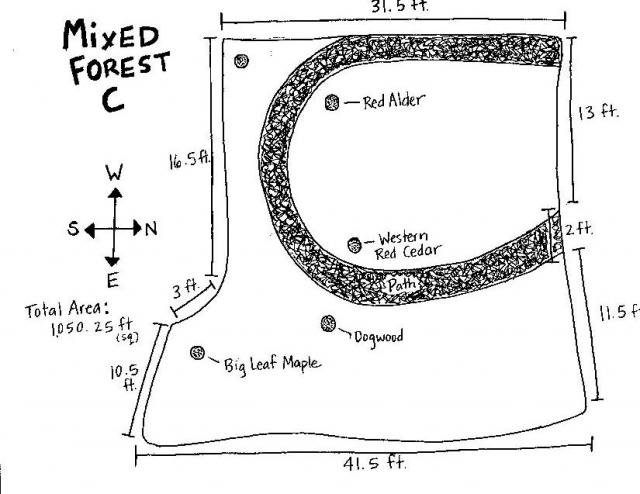User Login |
Mixed Forest C Introduction/DescriptionMixed Forest C Introduction and Theme attached at the bottom
Longhouse Garden Site Description Area Name: Mixed Forest C Habitat Type(s) Represented: Mixed forest Student Names: Michelle, Anastarr & Meg Habitat Intro (potential signage?) 2/2007 Mixed Forest C is representative of a forest in transition. From the wet, moist soil of the lower forest floor to the drier, more elevated section and even a forest clearing, this site is truly a mixed forest of the Northwest. Deciduous trees are prevalent, resulting in a diverse understory. This forest is best classified as a temperate broadleaf and mixed forest of the Puget Lowland. In the drier section, Goat’sbeard, Oregon Grape, Red-osier Dogwood, and *Oceanspray accompany a Big-leaf Maple abundant in moss. As you follow the forest towards the seasonal creek, there is a Western Red Cedar accompanied by Salal, Sword Fern, Lady Fern, Snowberry, *Trillium, and *Vanilla Leaf. Depending on the season, Coltsfoot pops up here and there and Horsetail pokes through, while Trailing Wild Blackberry can be found meandering year-round. There is a forest clearing with *Indian Plum, Bleeding Heart, Fringecup, and Nootka Rose, bordered by a patch of Salmonberry. The Red Alder at the apex of the trail speaks for the transition of the forest – can you imagine what other phases of life a forest like this has seen? The Western Redcedar (Thuja plicata) is the central theme of this forest, acting as the heart of the site. It has been and is still referred to as ‘the tree of life’, which comes from the Kwakwaka’wakw. In this tribe, as well as others, it was used to make important cultural items such as dugout canoes, house planks and posts, totem and mortuary poles, bentwood boxes, baskets, clothing and hats, and a variety of tools and implements such as dishes, arrow shafts, harpoon shafts, spear poles, barbecue sticks, fish spreaders and hangers, dip-net hooks, fish clubs, masks, rattles, benches, cradles, coffins, herring rakes, canoe bailers, ceremonial drum logs, combs, fishing floats, berry-drying racks, fish weirs, spirit whistles, and paddles. It was also used to drill and hearth for starting friction fires, and was considered to be an excellent fuel, especially for drying fish, because it burns with little smoke. It is still held with the highest respect by all Northwest Coast peoples for its healing and spiritual powers. There is a Coast Salish myth that says the Great Spirit created the Red Cedar in honor of a man who was always helping others. “When he dies and where he is buried, a cedar tree will grow and be useful to the people – the roots for baskets, the bark for clothing, the wood for shelter” (Stewart 1984:27). We are all very grateful to be able to breathe, interact, and learn from this healing tree of life. *=hoping to bring in Revised map to follow Site Description from Fall/2006 I. Overview This site is a mixed forest with predominately broadleaf deciduous trees. There is a u-shaped trail that goes through the site and acts as a dividing line between this site and the Seasonal Shady Creek site. There is a large rock at the apex of the path. The higher elevated part of the site along the paved path edge has plants that are not found in the inner, forested part of the site, so the site has good variety. 1. 2. The shape represents a boot. III. Our Feelings About the Site This site is already pretty well established but just needs some love to bring it back to its full potential.
Michelle, Anastarr & Meg
categories [ Forest Understory | Site Introduction ]
login or register to post comments | printer friendly version
|

